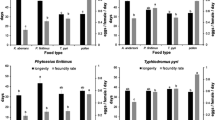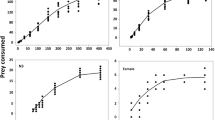Abstract
Survival in the laboratory of Mastrus ridens Horstmann (Hymenoptera: Ichneumonidae) reared on larvae of Cydia pomonella (Linnaeus) (Lepidoptera: Tortricidae) and five species of non-target Tortricidae was compared. Clutch size (numbers of eggs per host larva) and survival were higher on codling moth than on non-target species, and most adults reared from non-target larvae were smaller. F2 generation M. ridens adults reared on Argyroploce chlorosaris Meyrick and Cydia succedana (Denis and Schiffermüller) larvae were also small, with a sex ratio skewed to males. Few parasitoids survived, and they did not appear to have adapted to the non-target species on which their parents were reared. When M. ridens eggs were immediately removed from venom paralysed larvae, no codling moth larvae but most non-target larvae died within a few days. It is suggested that the host-paralysing venom of M. ridens is adapted to ensure the survival of codling moth larvae and is lethally maladapted to non-target species, such that it might be possible to determine ectoparasitoid host range by biochemical or physiological tools that characterise venom or prey response, respectively.

Similar content being viewed by others
References
Asgari S, Rivers DB (2011) Venom proteins from endoparasitoids wasps and their role in host-parasite interactions. Annu Rev Entomol 56:313–335
Bezemer TM, Mills NJ (2003) Clutch size decisions of a gregarious parasitoid under laboratory and field conditions. Anim Behav 66:1119–1128
Bezemer TM, Harvey JA, Mills NJ (2005) Influence of adult nutrition on the relationship between body size and reproductive parameters in a parasitoid wasp. Ecol Entomol 30:571–580
Charles JG, Dugdale JS (2011) Non-target species selection for host-range testing of Mastrus ridens. N Z Entomol 34:45–51
Charles JG, Sandanayaka WRM, Chhagan A, Page-Weir NEM (2013) Host selection behaviour in Mastrus ridens, a gregarious ectoparasitoid of codling moth, Cydia pomonella. BioControl (in press)
Gerling D, Rotary N (1973) Hypersensitivity, resulting from host-unsuitability, as exemplified by two parasite species attacking Spodoptera littoralis (Lepidoptera: Noctuidae). Entomophaga 18:391–396
Otten H, Wäckers F, Battini M, Dorn S (2001) Efficiency of vibrational sounding in the parasitoid Pimpla turionellae is affected by female size. Anim Behav 61:671–677
Pennacchio F, Strand MR (2006) Evolution of developmental strategies in parasitic Hymenoptera. Annu Rev Entomol 51:233–258
R development core team (2011) R: a language and environment for statistical computing. R foundation for statistical computing, Vienna, Austria. ISBN 3-900051-07-0, URL http://www.R-project.org/
Rivero A, West SA (2002) The physiological costs of being small in a parasitic wasp. Evol Ecol Res 4:407–420
Sandanayaka WRM, Chhagan A, Page-Weir NEM, Charles JG (2011) Colony optimisation of Mastrus ridens (Hymenoptera: Ichneumonidae), a potential biological control agent of codling moth in New Zealand. N Z Plant Prot 64:227–234
Singh P, Ashby MD (1986) Production and storage of diapausing codling moth larvae. Entomol Exp Appl 41:75–78
Strand MR, Casas J (2008) Parasitoid and host nutritional physiology in behavioural ecology. In: Wajnberg E, Bernstein C, van Alphen J (eds) Behavioral ecology of insect parasitoids. From theoretical approaches to field application. Blackwell, UK, pp 113–128
van Lenteren JC, Cock MJW, Hoffmeister TS, Sands DPA (2006) Host specificity in arthropod biological control, methods for testing and interpretation of the data. In: Bigler F, Babendreier D, Kuhlmann U (eds) Environmental impact of invertebrates for biological control of arthropods. Methods and risk assessment. CABI, UK, pp 38–63
Venables WN, Ripley BD (2002) Modern applied statistics with S, 4th edn. Springer, New York
Vinson SB, Iwantsch GF (1980) Host suitability for insect parasitoids. Annu Rev Entomol 25:397–419
Acknowledgments
We thank Robert Edwards, Graeme Clare and Anne Barrington for collecting and supplying G. molesta, codling moth, Ct. obliquana and P. octo larvae; Dr Toni Withers (Scion, Rotorua, New Zealand) for collecting C. succedana larvae; and Patrick Connolly for statistical analysis. This work was funded by New Zealand’s Ministry of Science and Innovation, Contract No: C06X0811, and by Plant and Food Research through core funding.
Author information
Authors and Affiliations
Corresponding author
Additional information
Handling editor: Dirk Babendreier
Rights and permissions
About this article
Cite this article
Charles, J.G., Manoharie Sandanayaka, W.R., Chhagan, A. et al. Survival of the gregarious ectoparasitoid Mastrus ridens on codling moth, Cydia pomonella, and non-target species. BioControl 58, 505–513 (2013). https://doi.org/10.1007/s10526-013-9518-y
Received:
Accepted:
Published:
Issue Date:
DOI: https://doi.org/10.1007/s10526-013-9518-y




